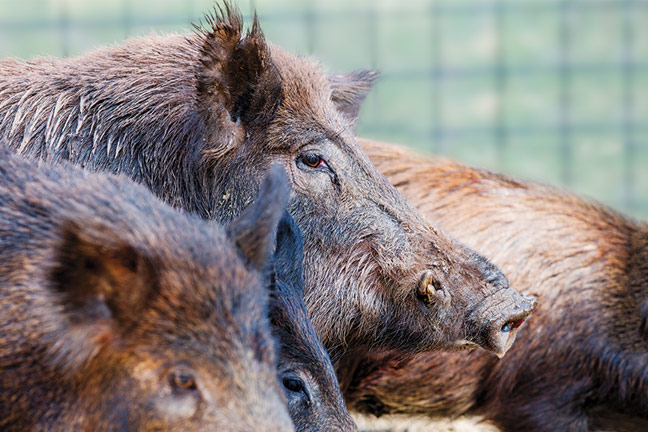
Agricultural News
Eradicating Wild Hogs to be the Focus of Oklahoma House of Representatives Interim Study
Tue, 26 Jul 2016 16:01:10 CDT
 Suggestions for controlling and reducing the infestation of feral hogs in Oklahoma will be reviewed during an interim legislative study this year requested by three members of the state House of Representatives.
Suggestions for controlling and reducing the infestation of feral hogs in Oklahoma will be reviewed during an interim legislative study this year requested by three members of the state House of Representatives.
The studies were requested by Reps. Brian Renegar, D-McAlester; Kevin Wallace, R-Wellston; and Sean Roberts, R-Hominy. House Speaker Jeff Hickman assigned the study to the House Committee on Agriculture and Rural Development, of which Renegar and Wallace are members.
The date, time and place of the feral hog study has not been established yet. Interim studies in the House will be conducted between Aug. 2 and Nov. 9.
Agriculture and wildlife officials estimate the wild hog population in Oklahoma at 430,000 to 1.6 million, and report the animals are present in all 77 counties. "It is very difficult to accurately measure the population, which is why the range is so large," said Betty Thompson, deputy commissioner of the Oklahoma Department of Agriculture, Food, and Forestry.
The Agriculture Department reports the wild pigs are especially abundant - 60 or more of the animals per square mile - along the Red River; in Johnston County; the Arbuckle Mountains of Murray County; and in western Comanche County throughout the Wichita Mountains Wildlife Refuge and the Fort Sill military reservation.
The feral hog population is deemed to be moderate (15 to 60 of the animals per square mile) in McCurtain, Choctaw, Bryan, Marshall, Love, Jefferson, Johnston, Latimer, Pittsburg, and western Caddo counties.
Feral hogs are responsible for extensive damage each year to agriculture land, to pastures, and even to golf courses and residential yards. Surveys by the Samuel Roberts Noble Foundation in Ardmore resulted in an estimate last year of approximately $1.5 billion in damages across the continental U.S. blamed on wild hogs.
Besides their destruction of valuable land, another concern with feral hogs is "the possible infection of pseudorabies virus which affects hogs, cattle, sheep, goats and dogs," said Renegar, a veterinarian. "We know the virus is in the animal's saliva and can live up to seven hours in the environment. We also know that feral hogs graze in the same pastures with other animals," such as horses and cattle, "and that it can be lethal in other livestock."
The state Agriculture Department contends that feral hogs can carry up to 30 diseases.
Earlier this year the Legislature endorsed Senate Bill 1142 by Roberts and Sen. Nathan Dahm, R-Broken Arrow, which was intended to reduce the number of feral hogs in this state. The legislation would have allowed feral hogs to be hunted on public or private property, day or night, without a hunting license and without notifying a game warden, if the hunter had permission from the landowner.
Governor Fallin vetoed the measure on May 20, citing potential safety issues.
Feral swine are an invasive species that "inflict significant damage" on property "and can hurt or even kill domestic livestock and other wildlife," the governor acknowledged in her veto message. "Although I support the intent of this bill - the bill's real-world application to public property like state parks and Wildlife Management Areas (WMAs) would create an unreasonable public safety threat and a conservation crisis."
Nevertheless, Fallin issued an executive order directing the Oklahoma Department of Wildlife Conservation to streamline its issuance of permits to exterminate feral hogs on private property.
Her Executive Order 2016-16:
? authorizes landowners on private property to remove feral swine at night, with the use of night-vision equipment, off-road vehicles to pursue or follow feral pigs, as well as hand-held or vehicle-mounted headlights or other powerful lights to pursue or follow feral hogs. However, at no time will pursuit of wild hogs on public roadways or the discharge of firearms from a public roadway be allowed.
? requires private landowners to agree to provide advance notification to a game warden before making any attempt to exterminate feral hogs.
The rules go into effect Nov. 1.
State agriculture and wildlife officials supported the governor's veto of SB 1142, contending it protects public safety and enhances the ability of the Wildlife Department to enforce laws against deer poaching during gun season.
Trapping "remains the best way to eradicate this invasive species," said Michael Teague, state Secretary of Energy and Environment.
Renegar concurred. Research by Texas A&M University "has proven that trapping is the single most effective tool for controlling feral hog populations when compared to other methods," he said.
"Many feral hogs are removed, at no cost to taxpayers, by state-licensed and state-inspected sporting facilities commonly referred to as hunting preserves or 'high fences'," Renegar related. "In fact the only effective measure we have in place to control feral hog populations is the network of trappers who transport feral hogs to these licensed facilities to be killed by hunters."
The hunting industry provides financial incentives for trappers to capture feral hogs, which in turn are purchased by licensed hunting ranches. "These preserves are properly fenced and inspected by the Department of Agriculture," Renegar said.
Owners/operators of the hunting preserves pay about $100 per head for each wild hog they release on their property, which attracts hunters from not only Oklahoma but also Texas, Nebraska, Missouri and Kansas, Renegar said.
He said he knows of one instance where three hunters from Indiana paid $600 each to hunt feral hogs on a private preserve in Pontotoc County. The sportsmen "also bought high-dollar boots for the occasion, stayed in cabins at the preserve, and bought gasoline and food from area merchants."
WebReadyTM Powered by WireReady® NSI
Top Agricultural News
More Headlines...




















